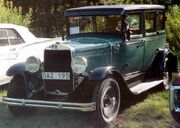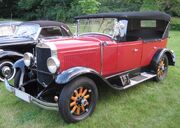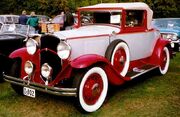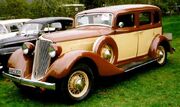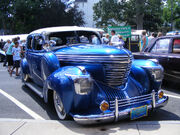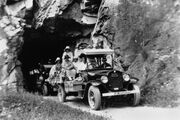| Founded | 1927 |
|---|---|
| Founder(s) | Joseph B. Graham, Robert C. Graham, Ray Austin |
| Defunct | 1962 |
| Headquarters | Evansville, IN, United States |
| Industry | automobiles, trucks |
Graham-Paige was an American automobile manufacturer. It operated from 1927 to 1962, by brothers Joseph B. Graham (September 12, 1882–July 1970) and Robert C. Graham (August 1885–October 3, 1967) and Canadian Ray Austin (May 28, 1887–August 13, 1932). In 1962 the company ceased to produce cars and instead went into real estate.
History[]
After successful involvement in a glass manufacturing company (eventually sold to Libbey Owens Ford) brothers Joseph B. Graham (September 12, 1882–July 1970) and Robert C. Graham (August 1885–October 3, 1967) and Canadian Ray Austin (May 28, 1887–August 13, 1932) began in 1927 to produce kits to modify Ford Model Ts and TTs into trucks. That led to the brothers building their trucks using engines of various manufacturers. Eventually they settled on Dodge engines, and soon the trucks were sold by Dodge dealers. The Grahams expanded from beginnings in Evansville, Indiana, opening plants in 1922 on Meldrum Avenue in Detroit, Michigan of 13,000 square feet (1,200 m²), and in 1925 in Stockton, California. The Canadian market was supplied by the Canadian Dodge plant. Dodge purchased the Graham Brothers truck firm in 1925, and the three Graham brothers took on executive positions at Dodge.
In 1927, with the banking syndicate controlling Dodge trying to sell the company, the Graham brothers decided to enter the automobile business on their own. In 1927, they purchased the Paige-Detroit Motor Company, makers of Paige and Jewett automobiles, for $4 million. Joseph became president, Robert vice-president and Ray secretary-treasurer of the company. The company's initial offering included a line of Graham-Paige cars with six- and eight-cylinder engines. For a while a line of light trucks was offered under the Paige name, soon discontinued when Dodge reminded the Grahams about the non-competition agreement they had signed as part of the sale of the Graham Brothers Company. Grahams earned a reputation for quality and sales quickly rose. Graham also had some success in racing, which helped boost sales. The Graham company logo included profiles of the three brothers and was used in insignia on the cars including badges and taillight lens.
Initially, Graham-Paige withstood the onset of the Great Depression well, but sales fell as the decade wore on. The 1932 models were designed by Amos Northup. This particular design has been noted as the "single most influential design in automotive history." The new 8-cylinder engine was called the "Blue Streak." However, the press and public quickly adopted the name "Blue Streak" for the cars themselves. The design introduced a number of innovative ideas. The most copied was the enclosed fenders, thus covering the mud and grime built up on the underside. The radiator cap was moved under the hood, which itself was later modified to cover the cowl, and end at the base of the windshield.
For engineering, the rear kickup on the chassis frame was eliminated by the adoption of a 'banjo' frame. Unlike contemporary practice, the rear axle was placed through large openings on both sides of the frame, with rubber snubbers to absorb any shock if the car axle should make contact. This in turn permitted a wider body. To help lower the car, the rear springs were mounted on the outer sides of the chassis frame and not under the frame. This idea was eventually copied by other manufacturers - Chrysler, for example, in 1957.
For 1934, Graham introduced a crankshaft-driven supercharger. At first offered only in the top eight-cylinder models, when the eights were dropped for 1936, the supercharger was adapted to the six. The unit was designed in-house by Graham Assistant Chief Engineer Floyd F. Kishline..[1] It was an original design, not a Switzer-Cummins or Duesenberg design. Through the years, Graham would produce more supercharged cars than any other automobile manufacturer until Buick surpassed them in the 1990s.
By 1935, the "Blue Streak" styling was getting rather dated. A restyling of the front and rear ends for 1935 proved to be a disaster, making the cars appear higher and narrower. Having no money for a new body, Graham signed an agreement with Reo, paying Reo $7.50 in royalties for each Hayes-built body. These were the basis of the 1936 and 1937 Graham cars.
Amos Northup of Murray Body was hired to design a new model for 1938. Unfortunately, he died before the design was complete. It is believed the final design was completed by Graham engineers.[2] The new 1938 Graham was introduced with the slogan "Spirit of Motion". The fenders, wheel openings and grille all appeared to be moving forward. The design was widely praised in the American press and by American designers. It also won the prestigious Concours D'Elegance in Paris, France. Wins were also recorded in the Prix d'Avant-Garde at Lyon, the Prix d'Elegance at Bordeaux, and the Grand Prix d'Honneur at Deauville, France.[3] Its cut-back grille later gained the car the name "sharknose", which appears to have origins in the 1950s. The styling was a complete flop in sales, and Graham limped through 1939 and 1940.
Desperate for a winning offering and unable to retool, Graham made a deal with Hupp Motor Co. in late 1939. According to the deal, the faltering company entered into an arrangement with Hupmobile to build cars based on the body dies of the stunning Gordon Buehrig-designed Cord 810/812. In an effort to remain in business, Hupp had acquired the Cord dies, but lacked the financial resources to build the car.
Graham agreed to build the Hupmobile Skylark on a contract basis, while receiving the rights to use the distinctive Cord dies to produce a similar car of its own, to be called the Hollywood. The striking Skylark/Hollywood differed from the Cord from the cowl forward with a redesigned hood, front fenders and conventional headlights, achieved by automotive designer John Tjaarda of Lincoln Zephyr fame. The Cord's longer hood was not needed, as the Hupp and Graham versions were rear-wheel drive. This also necessitated modifying the floor to accept a driveshaft.
However, the Hollywood did not stop the company's slide. It actually was a worse flop in the sales department for both Graham and Hupmobile than either firm's respective preceding models. The company suspended manufacturing in September, 1940, only to reopen its plant for military production for World War II.
The company resumed automobile production in 1946 producing a new car, the Frazer, named for Graham-Paige President Joseph Frazer, in partnership with Henry J. Kaiser. It also began production of farm equipment under the Rototiller name. In August 1945, Graham-Paige announced plans to resume production under the Graham name, but the plan never materialized. On February 5, 1947, Graham-Paige stockholders approved the transfer of all their automotive assets to Kaiser-Frazer, an automobile company formed by Frazer and Kaiser, in return for 750,000 shares of Kaiser-Frazer stock and other considerations. Graham's manufacturing facilities on Warren Avenue were sold to Chrysler, who used the plants first for DeSoto body and engine production, and finally for assembly of the Imperial for the 1959, 1960, and 1961 model years.
Post-automotive legacy[]
Graham-Paige dropped the "Motors" from its name and went into real estate, buying up such properties as the Roosevelt Raceway in New York and Madison Square Gardens. In 1962, the firm changed its name to the Madison Square Garden Corporation, which was later absorbed by Gulf & Western Industries. Currently Madison Square Garden is part of Madison Square Garden, L.P., of which a majority interest is owned by Cablevision Systems Corporation.
See also[]
References[]
| This page uses some content from Wikipedia. The original article was at Graham-Paige. The list of authors can be seen in the page history. As with Tractor & Construction Plant Wiki, the text of Wikipedia is available under the Creative Commons by Attribution License and/or GNU Free Documentation License. Please check page history for when the original article was copied to Wikia |
Keller, ME (1988). The Graham Legacy: Graham-Paige to 1932. Turner Publishing Company. ISBN 1563114704.
